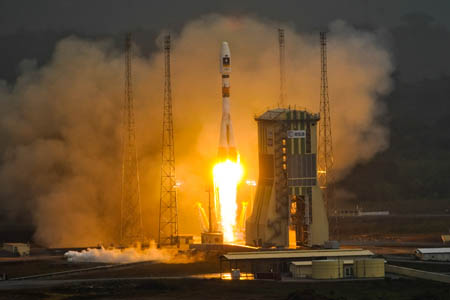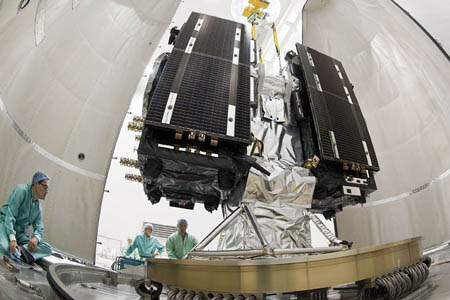
The Soyuz takes off carrying the first Galileo system satellites. Photo: Stephane Corvaja/ESA/CNES/Arianespace
The first two satellites for the new European rival to the GPS system were successfully launched into orbit today, after a day’s delay.
The pair of Galileo global navigation system satellites were carried into space on one of the oldest rocket systems still operating.
The Russian Soyuz rocket is based on the design of launcher used to take the world’s first orbiter, Sputnik, and first cosmonaut, Yuri Gagarin, into space more than 50 years ago.
The launch of the two Galileo satellites is the first stage in the establishment of a new, more accurate satellite navigation system that engineers promise will give an accuracy of one metre for outdoor enthusiasts and other users who have compatible receivers.
It will also form part of the global rescue satellite system. The lift off took place at 11.30am British Summer Time from the new Spaceport in French Guiana, which enables heavier payloads to be put into orbit because of its position close to the equator.
Jean-Jacques Dordain, director general of the European Space Agency, said: “This launch represents a lot for Europe: we have placed in orbit the first two satellites of Galileo, a system that will position our continent as a world-class player in the strategic domain of satellite navigation, a domain with huge economic perspectives.
“Moreover, this historic first launch of a genuine European system like Galileo was performed by the legendary Russian launcher that was used for Sputnik and Yuri Gagarin, a launcher that will, from now on, lift off from Europe’s Spaceport.
“These two historical events are also symbols of cooperation: cooperation between ESA and Russia, with a strong essential contribution of France; and cooperation between ESA and the European Union, in a joint initiative with the EU.
“This launch consolidates Europe’s pivotal role in space cooperation at the global level.
“All that has been possible thanks to the vision and commitment of ESA member states.”
The two Galileo satellites are part of the in-orbit validation phase that will see the Galileo system’s space, ground and user segments extensively tested.
The satellites are now being controlled by a joint ESA and CNES French space agency team in Toulouse, France. After these initial operations, they will be handed over to SpaceOpal, a joint company of the DLR German Aerospace Centre and Italy’s Telespazio, to undergo 90 days of testing before being commissioned for the IOV phase.
The next two Galileo satellites, completing the IOV quartet, are scheduled for launch in summer 2012.
The system is planned to be fully operational by the end of the decade. Galileo has been designed to work in conjunction with the existing American Global Positioning System and the Russian Glonass network.

Margaret
10 December 2011The American Global Positioning System (GPS) is called NAVSTAR in the same way the European Global Positioning System (GPS) is called GALILEO